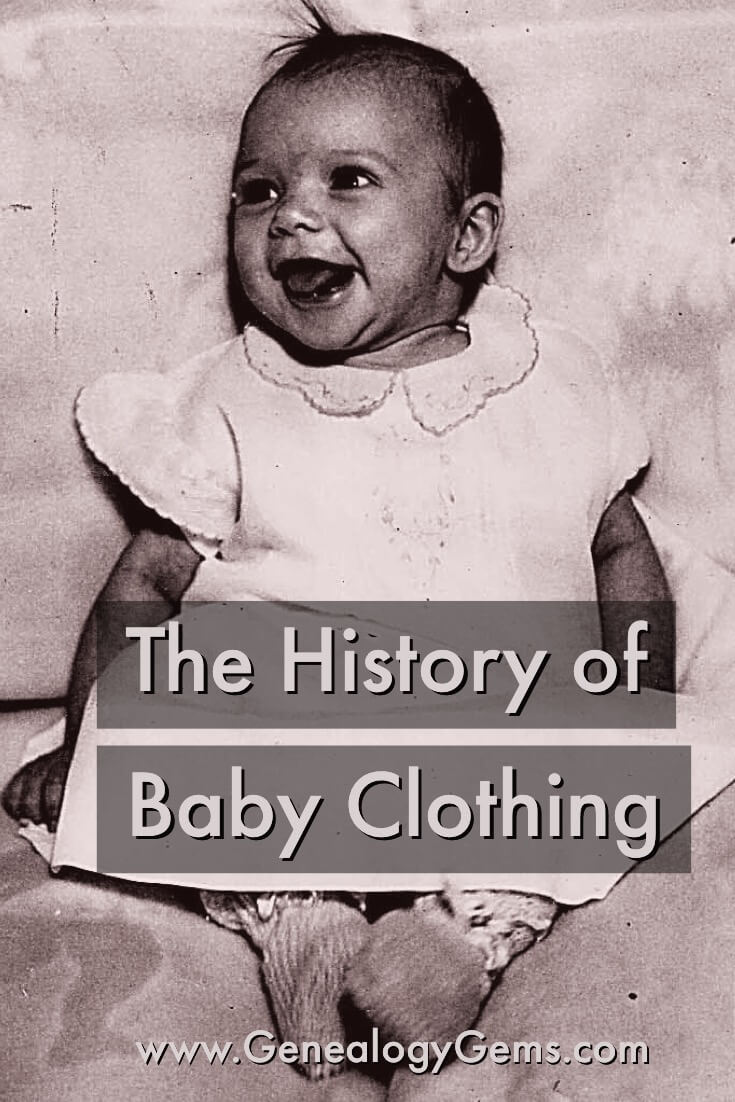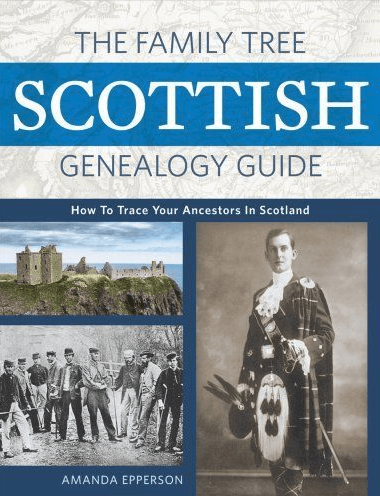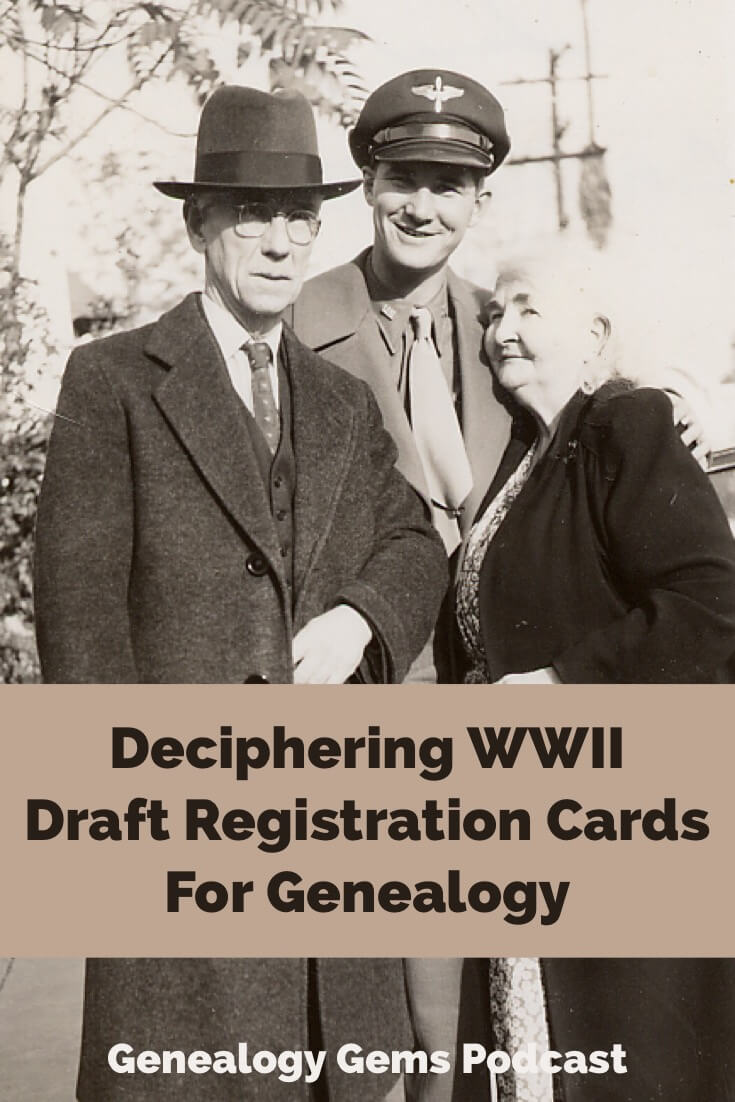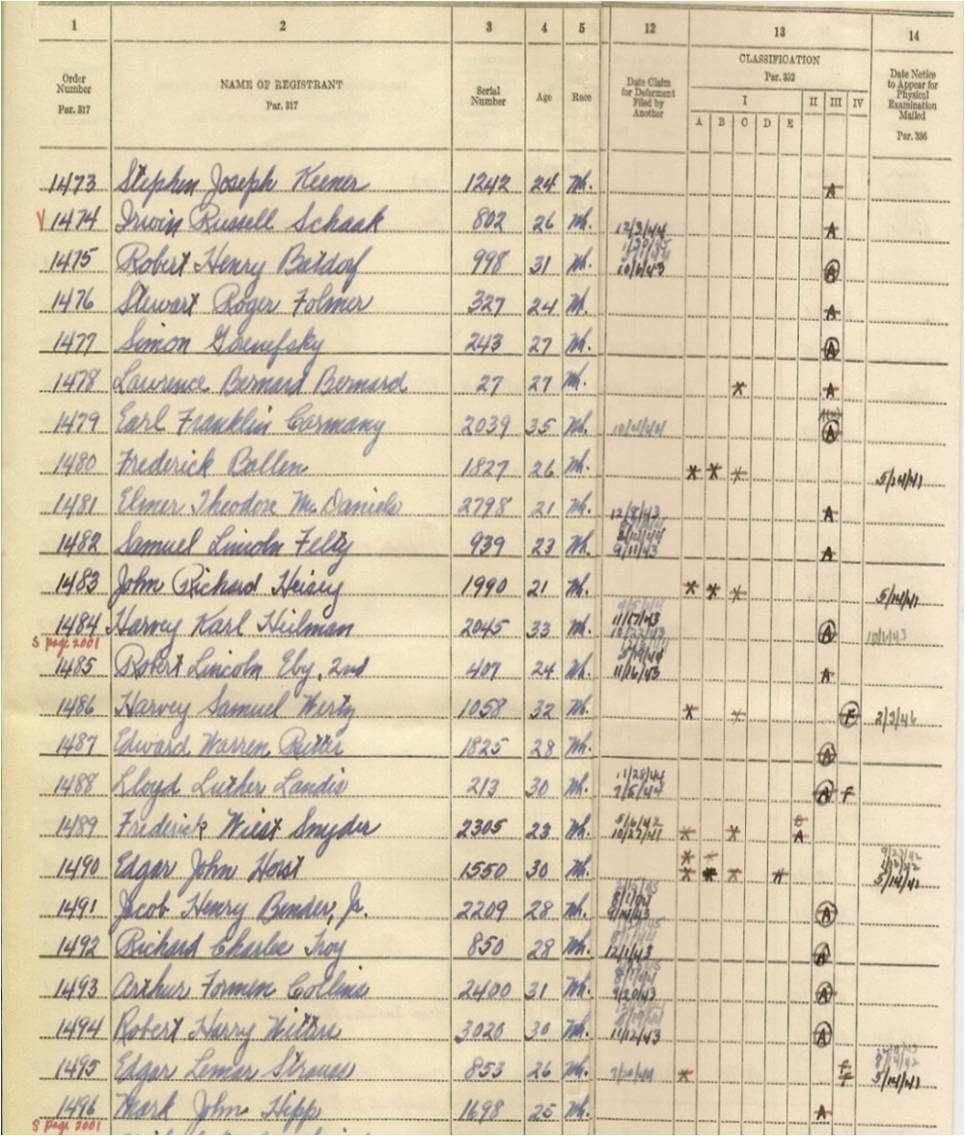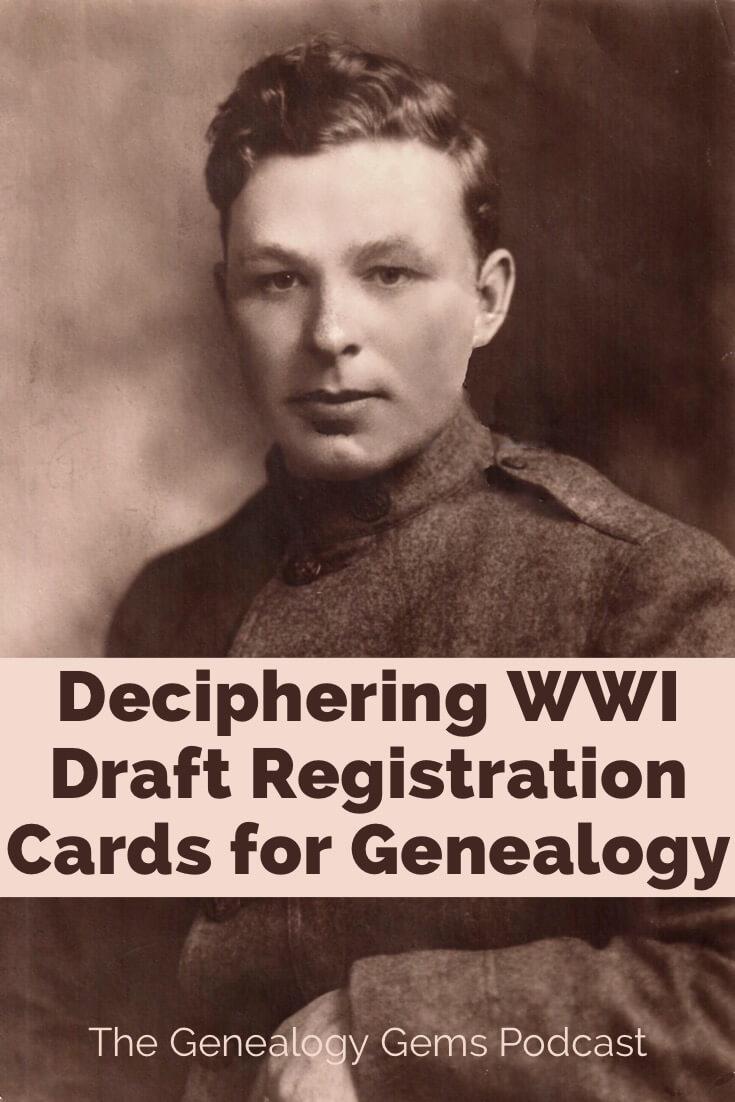Blog

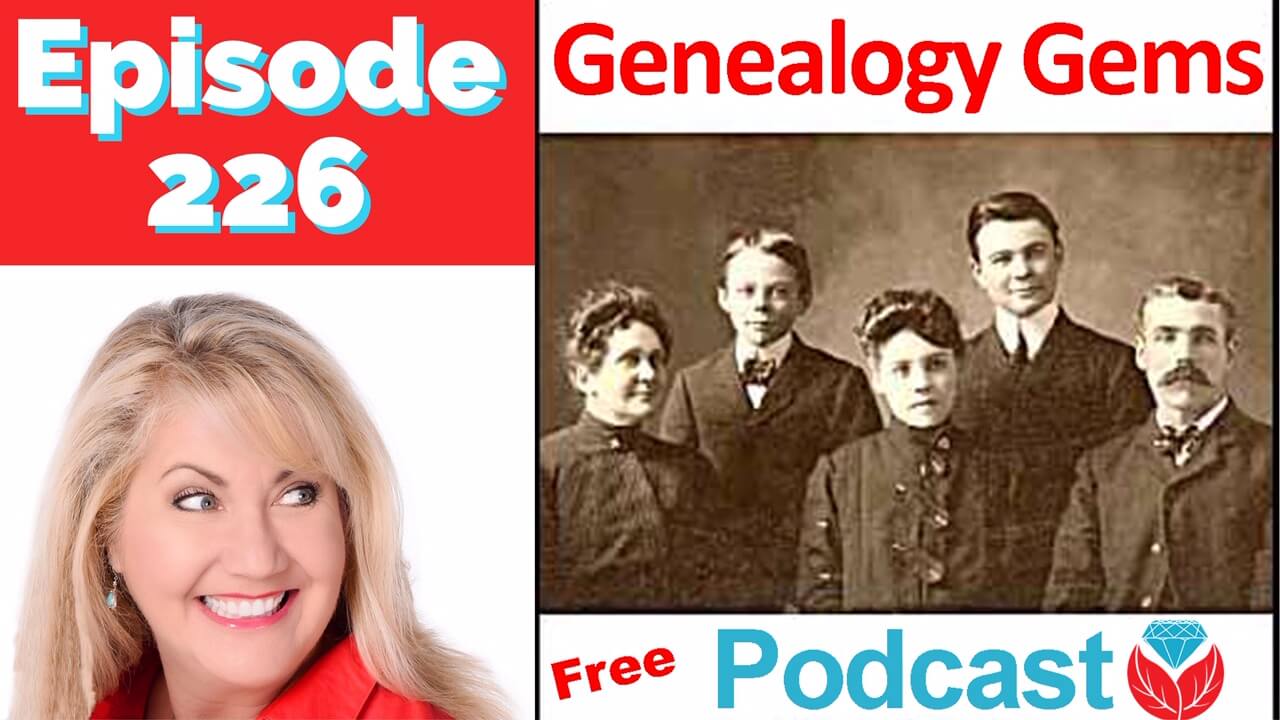
Episode 226: The Free Genealogy Gems Podcast
Episode 226
Welcome, my friend, to the podcast where we take joy in the discovery of your family’s history! In today’s show we’ll cover:
- research strategies and new resources
- the history of your ancestors’ baby clothing
- a tech tip that protects you
- and the key to deciphering draft registration cards
Download the episode (mp3)
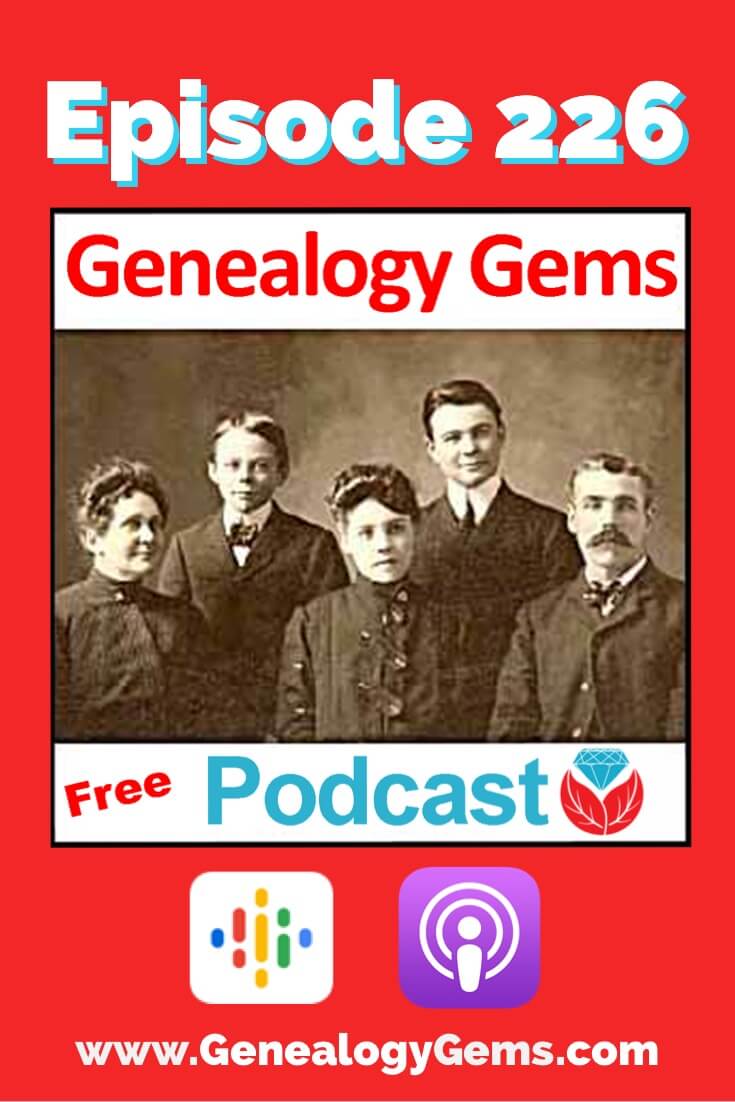
GENEALOGY NEWS:
GEM: They Shall Not Grow Old
There are so many things I want to cover every month, but I try really hard to sift through it all and bring you the best of the best, the genealogy gems. And I LOVE when you bring me Gems! Just like Betty did recently.
Betty is taking my online course at Family Tree University this month called Google Earth for Genealogy which I told you about in our weekly newsletter. You’re all signed up for that right?
Well Betty was so excited about something she found that she wrote the following on our course discussion board.
She says: “My husband and I just saw the movie “They Shall Not Grow Old” about the soldiers in WWI. We saw it in 3-D, which was amazing! The whole movie is remastered, colorized video and audio from the newsreels and also the soldiers’ interviews in the 1960’s and 70’s. The director, Peter Jackson, introduces the movie and then, the best part is after the show.”
Watch the trailer:
I saw her message at about 8:00 that night, and I immediately grabbed Bill and jumped in the car and for the 9:30pm showing. I couldn’t agree more that it was spectacular.
From Betty: “When I read that you went straight to the movie, I almost cried I was so happy! I knew you would like the last 1/2 hour the best. When Peter Jackson talked about everyone finding out about the history of their family, I was so excited! Wasn’t it amazing what they could do with old video, still shots, cartoons, and audio interviews? It has so much potential for genealogists. The most important thing is to gather the information and digitize the videos we already have. In the future, maybe the technology will be more accessible to us, non-professional family historians. What a treasure that movie was! I hope it inspires more people to do the same with other aspects of WWI or other historical subjects.”
GEM: Baby Clothes
Valentine’s Day brings to mind visions of cupid, a baby dressed only in a nappy shooting arrows of love at unsuspecting couples. While this little cherub celebrates the holiday au natural, let’s take some time to talk about the fashion statements the babies in our family tree have made through the centuries. To help us visualize the togs those tots wore we could turn to our grandmother’s photo albums, but there we may find a surprise: lots of photos of female ancestors and surprisingly fewer of the males. Why is that? Allison DePrey Singleton, Librarian at the Allen County Public Library Genealogy Center unravels the mystery and stitches together a delightful history of baby clothing.
Sources:
Baumgarten, Linda. What clothes reveal: the language of clothing in colonial and federal America: the Colonial Williamsburg Collection. Williamsburg, VA: Colonial Williamsburg.
Calvert, Karin Lee Fishbeck. Children in the house: the material culture of early childhood, 1600-1900. Boston: Northeastern University Press, 1992.
F., José Blanco, Mary D. Doering, Patricia Hunt-Hurst, and Heather Vaughan Lee. Clothing and fashion: American fashion from head to toe. Vol. 1-3. Santa Barbara, CA: ABC-CLIO, an imprint of ABC-CLIO, LLC, 2016.
Hiner, N. Ray., and Joseph M. Hawes. Growing up in America: children in historical perspective. Urbana: University of Illinois Press, 1985.
Paoletti, Jo B. “Clothing and Gender in America: Children’s Fashions, 1890-1920.” Signs: Journal of Women in Culture and Society 13, no. 1 (1987): 136-43. doi:10.1086/494390.
Paoletti, Jo Barraclough. Pink and blue: telling the boys from the girls in America. Bloomington: Indiana University Press, 2012.
“When Did Girls Start Wearing Pink?” Smithsonian.com. Accessed January 10, 2017. http://www.smithsonianmag.com/arts-culture/when-did-girls-start-wearing-pink-1370097/.
MAILBOX:
Mary Lovell Swetnam, Special Collections Librarian Virginia Beach Public wrote me to tell us all about a new online resource. “I was able to determine that hundreds of records of enslaved persons were not included in either of the two previous abstracts of the Overwharton Parish Register. They have now been abstracted and are available free on our site.
Please see the link below. I have also included a copy of the explanatory material for the project. http://cdm16450.contentdm.oclc.org/cdm/compoundobject/collection/p16450coll15/id/14/rec/2.”
Dana wrote in with one purpose in mind: to share her genealogy happy dance with us. And I think that’s an awesome reason to write! Email or leave a voice mail at (925) 272-4021 and share your genealogy happy dance with me!
GEM: Scottish Genealogy
Amanda Epperson Ph.D. shares 3 strategies for finding an ancestor in Scottish records. Read the full article here.
Amanda Epperson is the author of the book The Family Tree Scottish Genealogy Guide. Since completing her Ph.D. in history from the University of Glasgow in 2003, Amanda has taught history at the college level, researched and edited family histories, most recently for Genealogists.com, and written articles for a variety of publications including Family Tree Magazine and Your Genealogy Today.
Become a Genealogy Gems Premium eLearning Member
Gain access to the complete Premium podcast archive of over 150 episodes and more than 50 video webinars, including Lisa Louise Cooke’s newest video The Big Picture in Little Details.
TECH GEM: Locate My Computer with Backblaze
Backblaze executive Yev Pusin explains a little-known feature that just might get you out of a jam! Learn more about Backblaze computer cloud backup and get your computer backed up today at www.backblaze.com/Lisa
GEM: Military Minutes – Draft Registration Cards Deciphered
We are revisiting Draft Registrations for both World War I and World War II. You will recall that this was the subject of our first “Military Minutes” together; since this aired several listeners have had questions and comments regarding the numbering on the cards, draft classifications, and how to dig deeper into other records of the Selective Service System whose office was responsible for the registering of all the men during both wars.
Click the images below to see all of the documents Michael discusses in this episode:
GEM: Profile America – America’s First Hospital
Monday, February 11th. Among his very many achievements, Benjamin Franklin played a leading role in the founding of America’s first hospital. Together with Dr. Thomas Bond, he obtained a charter for a hospital to serve the poor, sick and insane in Philadelphia. The Pennsylvania Hospital opened on this date in 1752 in a converted house.
Sources:
Joseph Nathan Kane, Kane’s Famous First Facts, Fifth Edition, H.W. Wilson Co., New York, NY 1997, 4868
Hospitals and employment, County Business Patterns, NAICS 622
Hospital revenue, Economic Census, NAICS 622
PRODUCTION CREDITS
Lisa Louise Cooke, Host and Producer
Bill Cooke, Audio Editor
Lacey Cooke, Your Happiness Manager
Disclosure: As an Amazon Associate, Genealogy Gems earns from qualifying purchases you make when clicking from the links we provide. It doesn’t cost you anything extra but it helps support our free blog and podcast. Thank you!
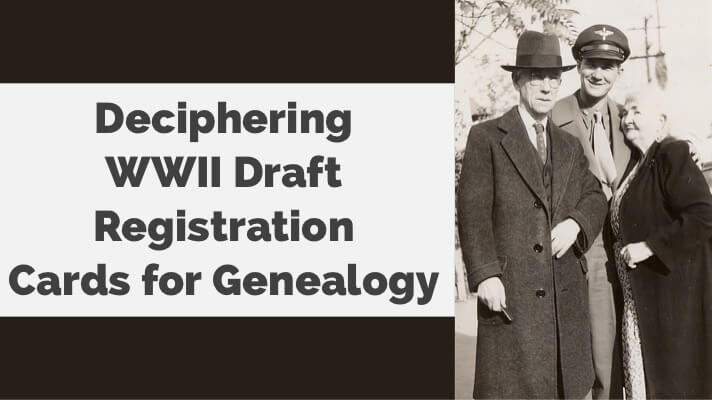
Deciphering Draft Registration Cards for Genealogy: World War II
Our Military Minutes Man Michael Strauss revisits the first subject he covered with us on the Genealogy Gems Podcast: Draft Registrations for both World War I and World War II. This is Part 2, covering WWII. Click here to read Part 1 for background about the numbering on the cards, draft classifications, and the Selective Service System. Then read on to learn all about WWII draft registration records.
Michael has the answers for us. Attention, March!
The World War II Draft:
On the eve of World War II, our country witnessed the passage of another national conscription act. It was called the Selective Training and Service Act of 1940 (54 Stat. 885). It turned out to be the first peacetime act in United States history. With a growing population for the United States, this meant that the draft process would be greatly expanded with more registrants.
All men regardless of citizenship status between the ages of 18 and 65 were registered in seven separate classification groups. Like the previous Selective Service Act of 1917 and the draft cards, these draft cards also recorded similar information on the upper left corner, which included the serial number, and the order number in the upper right corner, with nearly the same process being followed.
On October 29, 1940 Secretary of War Henry L. Stimson drew numbers from a bowl representing the first registration for men between 21-36.
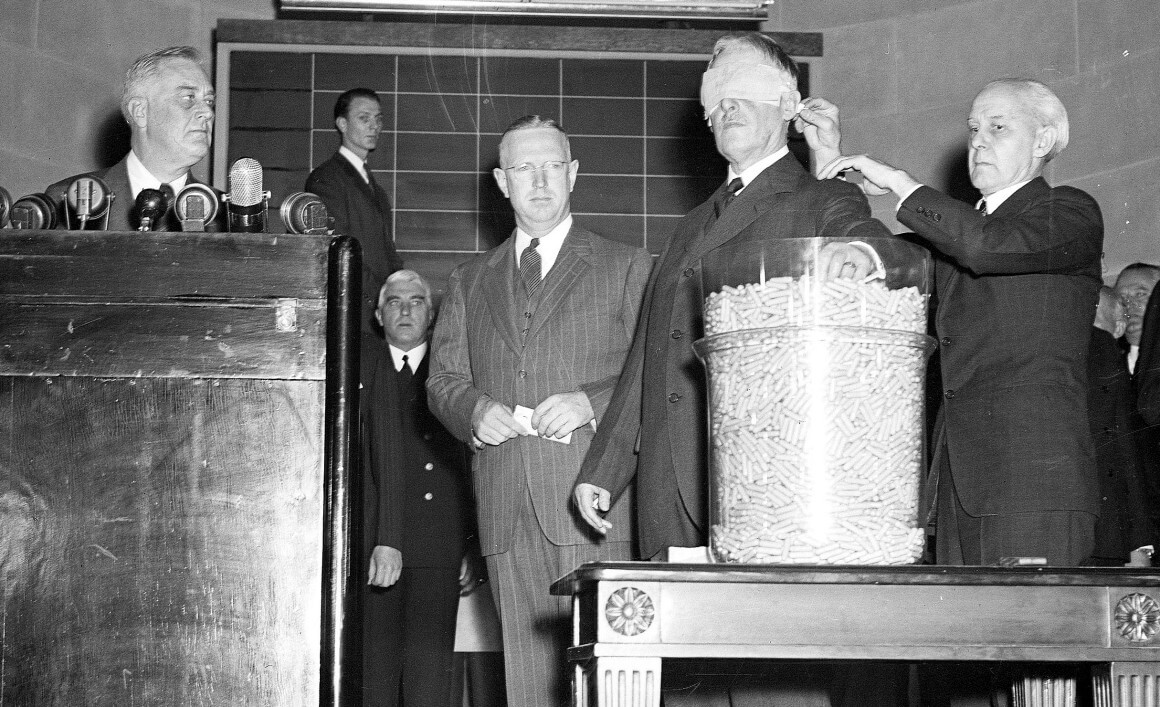
Image courtesy of Library of Congress in Washington, DC showing Secretary of War Henry Stimson drawing the first number for Draft in 1940 for World War II
The first number drawn of the 7,836 serial numbers that were printed on paper and placed in individual capsules was No. 158. This number belonged to Harry Robert Bell, a 21-year-old from Washington D.C. (see image below). The hundreds of men across the United States pulled in this first drawing were all given an order number of 1.
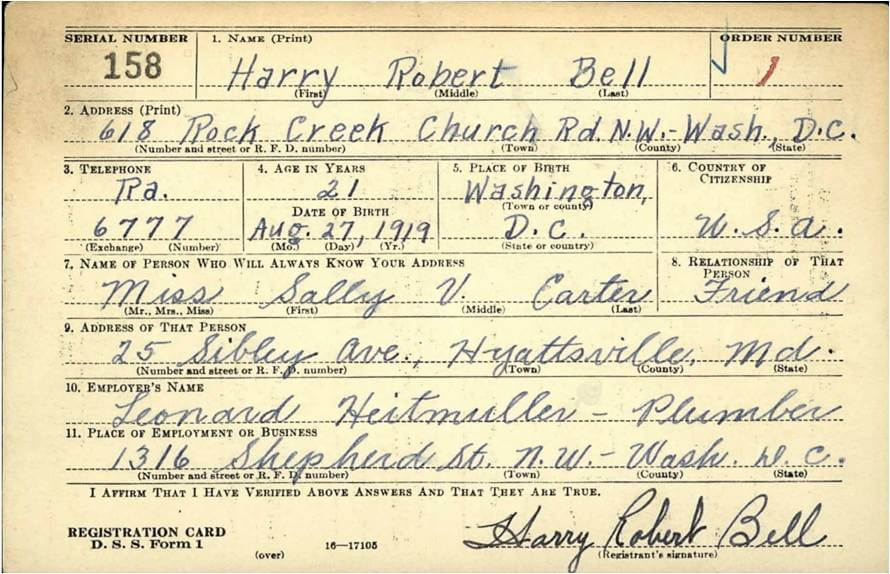
Harry Robert Bell-WWII Draft Card-First Person Drafted
World War II Draft Registration Cards
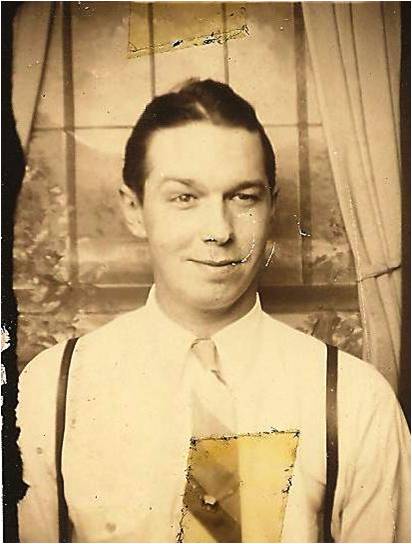
Edgar L. Strauss (photo courtesy of Michael Strauss)
Genealogists can determine which of the seven draft registrations cards their ancestors filled out by noting the letters that were placed in front of the serial numbers for five of the seven registrations:
- 2nd registration is preceded by an “S”
- 3rd registration is preceded by a “T”
- 4th registration (or Old Man’s Draft) is preceded by a “U”
- 5th registration is preceded by an “N”
- 6th registration is preceded by a “W”
Only the 1st and 7th were not lettered before the numbering system.
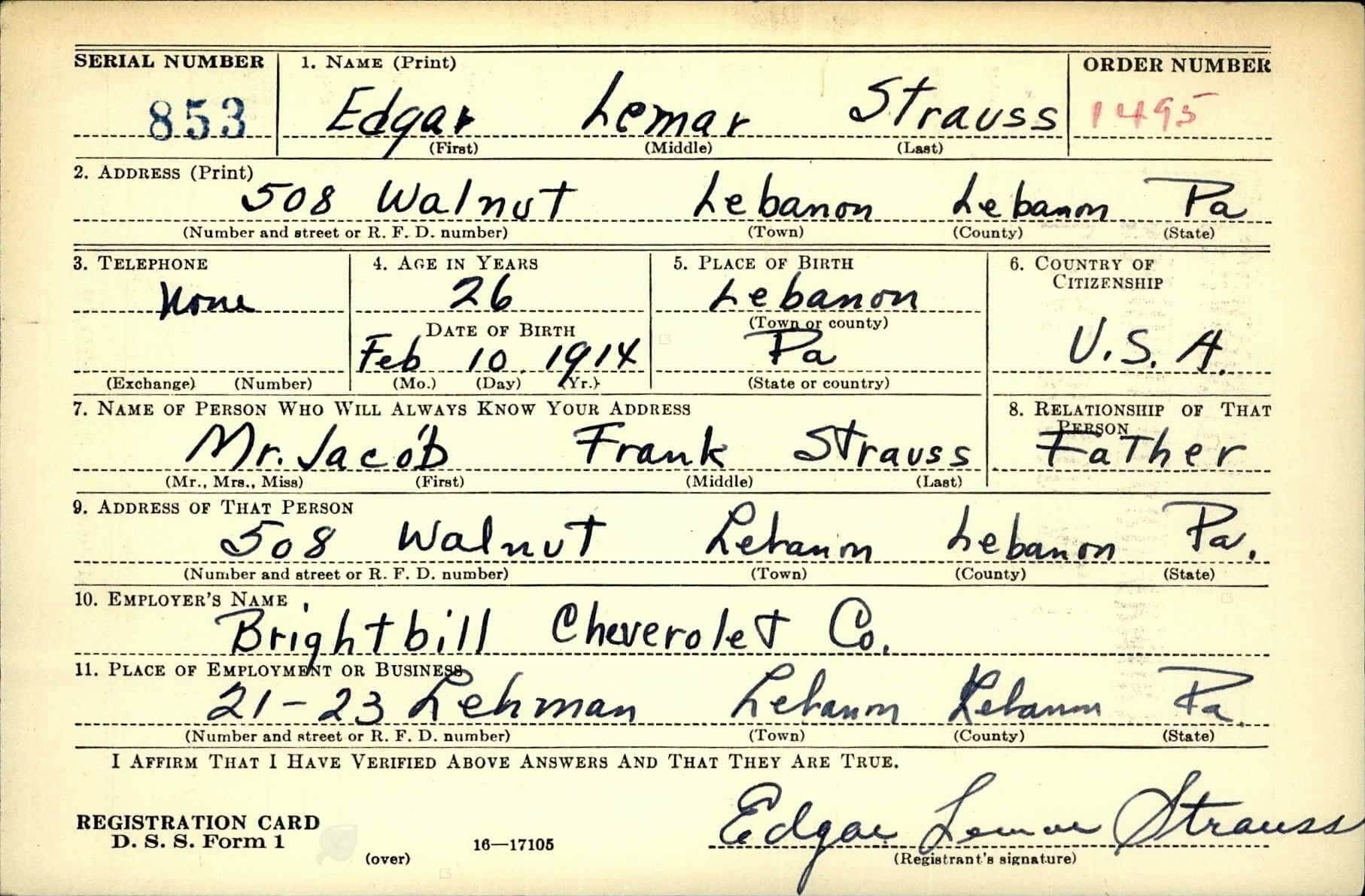
Edgar L. Strauss-WWII Draft Card (image courtesy of Michael Strauss)
On the back of the card is stamped the local draft board number and location where the registrant went to fill out the form. These were cataloged nearly the same way as the previous war with the State, District Number, and local Board. The National Archives in College Park, MD has a master list of all the draft board numbers and locations alphabetically by state and territory.
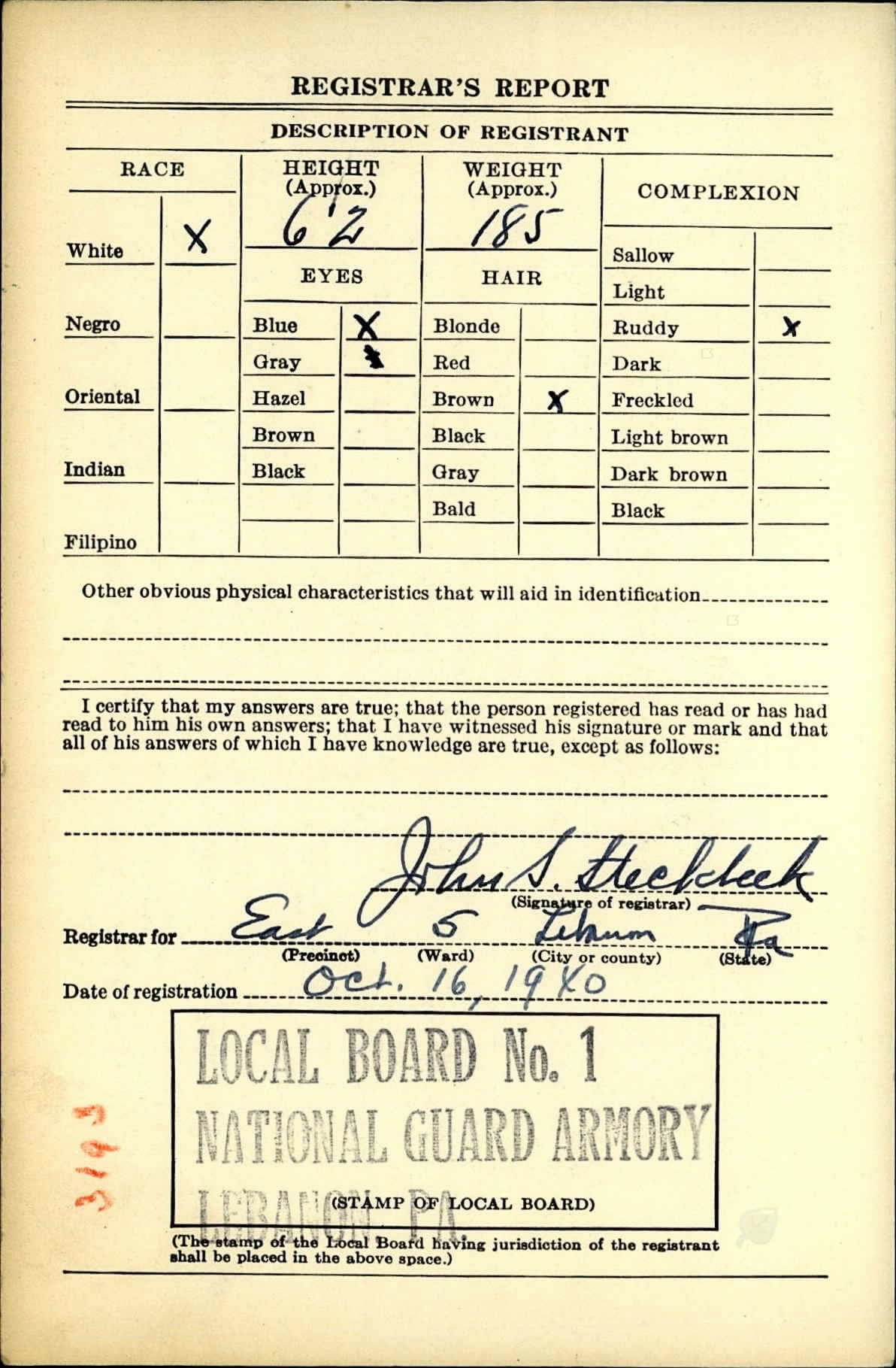
Edgar L. Strauss-WWII Draft Card-Back (Image courtesy of Michael Strauss)
Contact the National Personnel Record Center in St. Louis, MO to obtain copies of the Draft Classifications for World War II and subsequent periods, and dockets to determine the status. During World War II, draft classifications were listed using first a “Roman Numeral and then a Letter” giving the status of each registrant.
Some of the more common Classifications included:
- I-A Fit for military service (could be inducted into service)
- II-B Deferred necessary to National Defense
- III-A Service deferred to hardship/Dependents
- III-B Occupation vital to War Effort
- IV-D Minister of religion
- IV-E Conscientious Objector
- IV-F Rejected For Military Service
Image above: WWII Draft Classification List including Edgar L Strauss – Order #1495. (Courtesy of Michael Strauss)
For a complete listing of all of the classifications for World War I through World War II and including post-war service for the Vietnam and Korean warm, contact the college at Swarthmore University in Pennsylvania. They have recorded each of the listings along with explanations. Once this is done, contact the Archives in College Park, MD to obtain other Selective Service records. All records are part of Records Group 147.
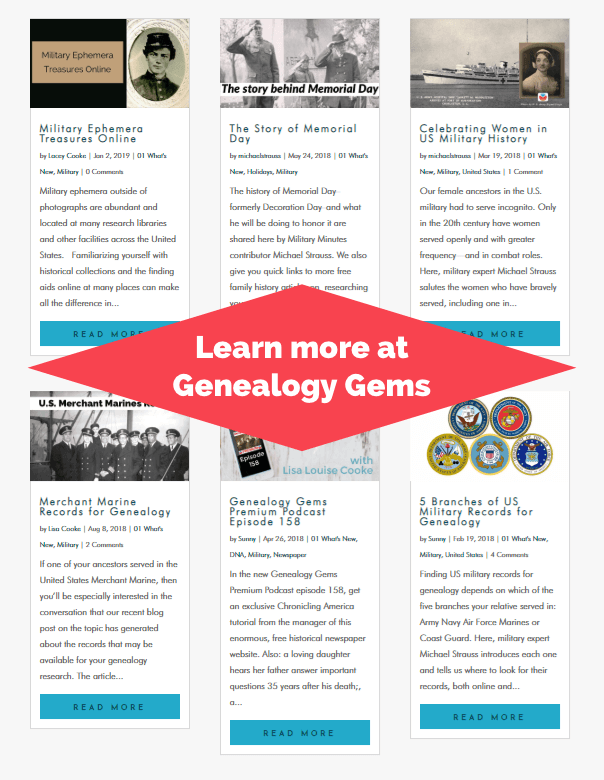 Resources for Learning More About World War I and Military History
Resources for Learning More About World War I and Military History
Move backward in time from World War II to the Great War with Michael’s article Deciphering Draft Registration Cards for Genealogy: World War I.
Then, click the image on the right to head to our comprehensive collection of articles on military history.

Author: Michael Strauss, AG
Michael Strauss, AG is the principal owner of Genealogy Research Network and an Accredited Genealogist since 1995. He is a native of Pennsylvania and a resident of Utah and has been an avid genealogist for more than 30 years. Strauss holds a BA in History and is a United States Coast Guard veteran.
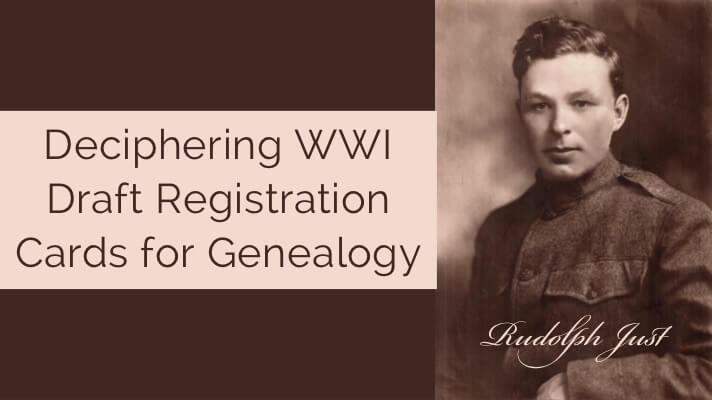
Deciphering Draft Registration Cards for Genealogy: World War I
Our Military Minutes Man Michael Strauss revisits the first subject he covered with us on the Genealogy Gems Podcast: Draft Registrations for both World War I and World War II. Since that first segment aired several listeners have had questions and sent in comments regarding:
- the numbering on the cards,
- draft classifications,
- and how to dig deeper into other records of the Selective Service System whose office was responsible for the registering of all the men during both wars.
This is Part 1, examing WWI draft registrations. Michael has the answers for us. Attention, March!
World War I Draft Registrations:
When the United States entered the war on April 6, 1917 we were totally unprepared to wage a global war. The Selective Service Act of 1917 (40 Stat. 76) passed by Congress on May 18, 1917 authorized the President of the United States to increase the armed forces through conscription. The Act directed the Provost Marshal General Office (P.M.G.O.) to select men eligible for military service.
All men between the ages of 18 and 45 were required to register regardless of citizenship status or other factors.
Three Separate Draft Registrations During World War I
The draft was then divided into three separate registrations:
- The 1st draft registration was dated June 5, 1917, for men aged 21 to 31. On July 20, 1917, 10,500 numbers were drawn by Secretary of War Newton Baker.
- The 2nd draft registration was dated June 5, 1918, for men who had turned 21 since the previous registration and included a supplemental registration on August 24, 1918. It was for men turning 21 after June 5, 1918. On June 27, 1918, 1200 numbers were drawn by the Secretary of War.
- The 3rd draft registration was dated September 12, 1918. It was intended for all men aged 18 to 45 years. On October 1, 1918, 17,500 numbers were drawn by the Secretary of War.
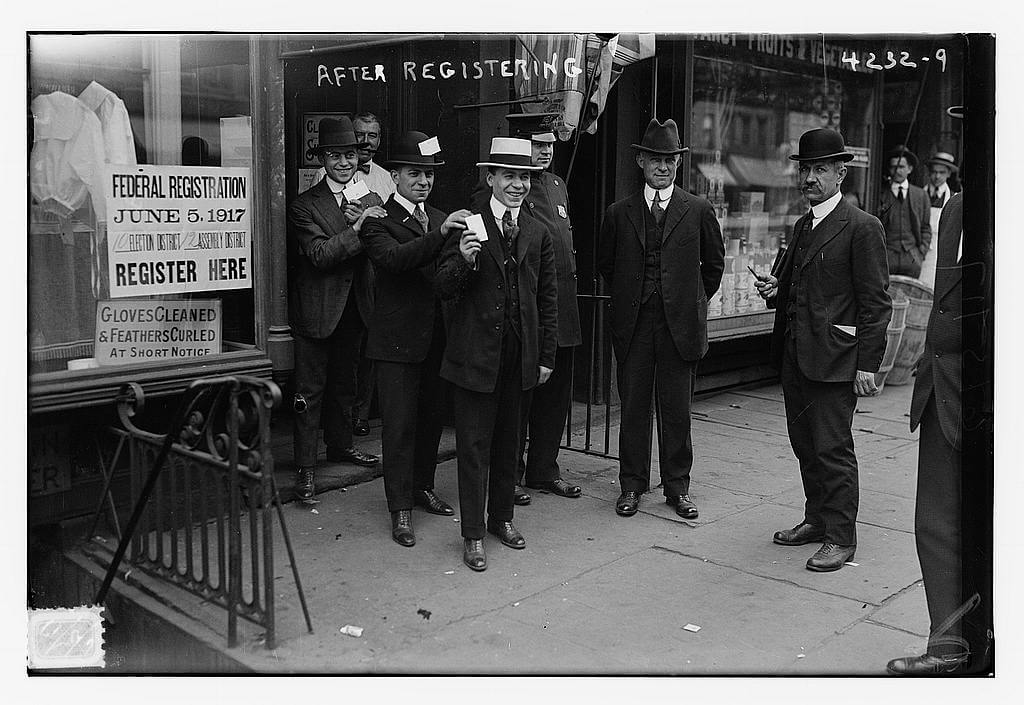
NYC- Registering for the Great War
Deciphering World War I Draft Registration Cards & Numbering
On the corners of each registration card are stamped or written a series of numbers; on the left is the serial number that was assigned as soon as they registered. It could also be the number that the registrant was in line the day the cards were filled out. After each registration was complete at the local boards, the headquarters of the Selective Service in Washington DC placed each of the serial numbers into a container.
On July 20, 1917, Secretary of War Newton Baker drew the first of 10,500 numbers from a bowl for the 1st registration.
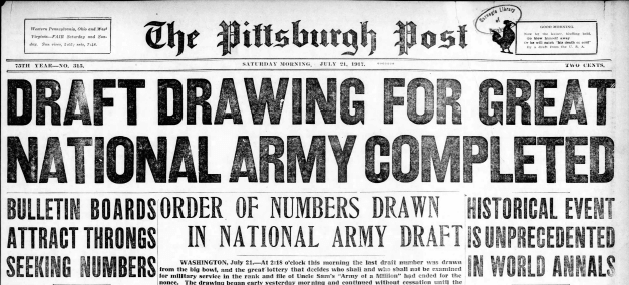
The first number drawn was No. 258 for which every person who registered was given an order number of 1. This was repeated until each serial number has an order number. The image below shows the order of the numbers drawn from the 1st Registration as was published in the Pittsburgh Post on July 21, 1917.
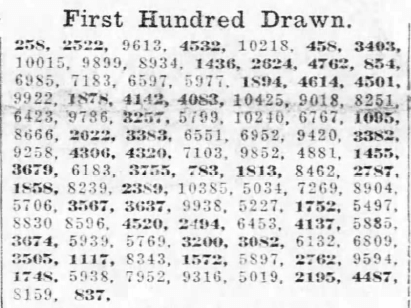
Pittsburgh Daily Post July 21, 1917
On the back of the registration cards was stamped another series of numbers followed by a letter designation. Example below: Ellis L. Keller who resided at 340 N. Partridge Avenue in Lebanon, Pennsylvania.
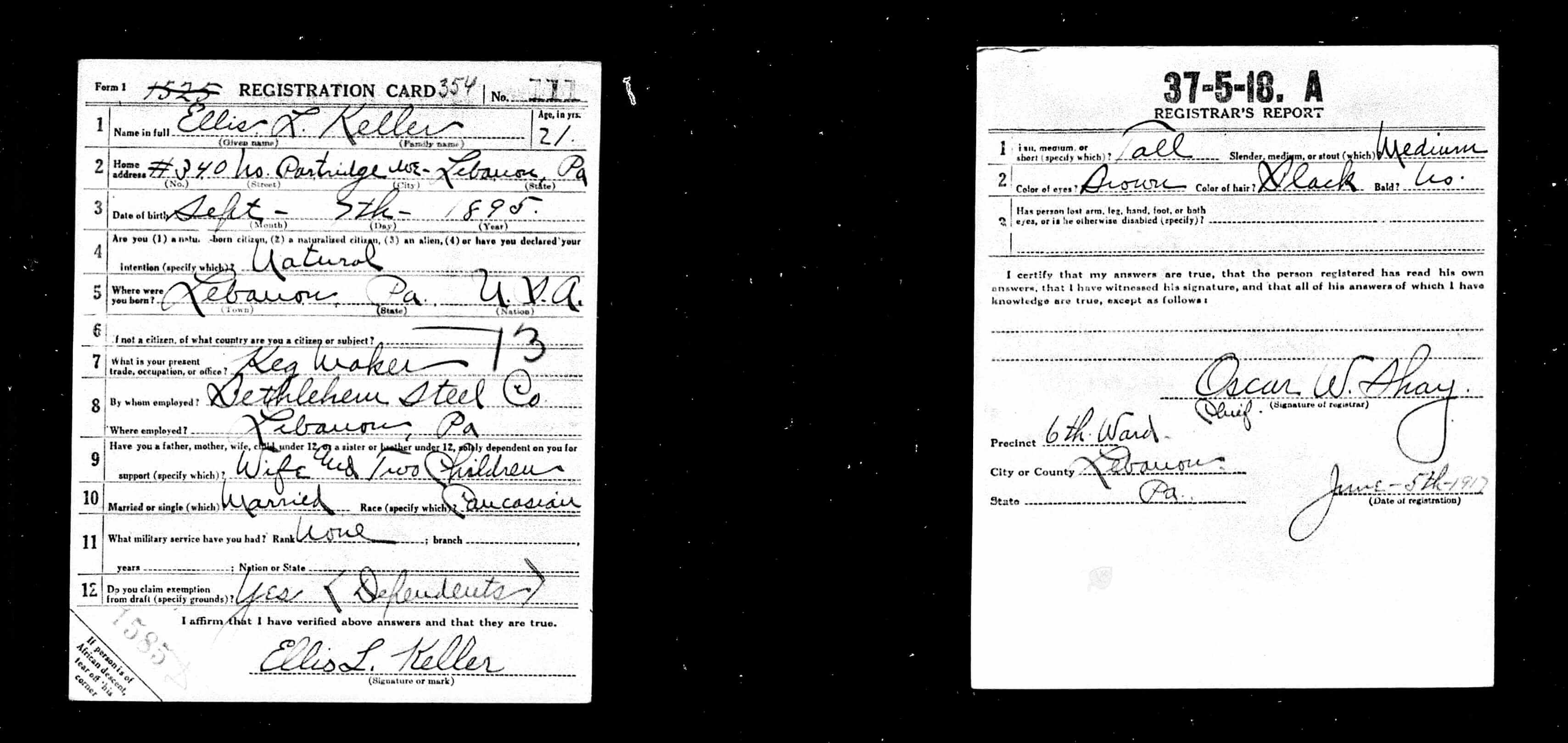
On the back of the card it has stamped 37-5-18 [then a space] A. These numbers and letters provide additional clues:
- The first number represents the state (37 represents Pennsylvania)
- The second digit represents the District Board Number
- The last number 18 is the Local Board Number
- Following each number is a series of letters, either “A, B, or C,” which will correspond respectfully with the 1st, 2nd, or 3rd draft registration
For the above example of Ellis L. Keller, his draft registration was part of the 1st Registration.
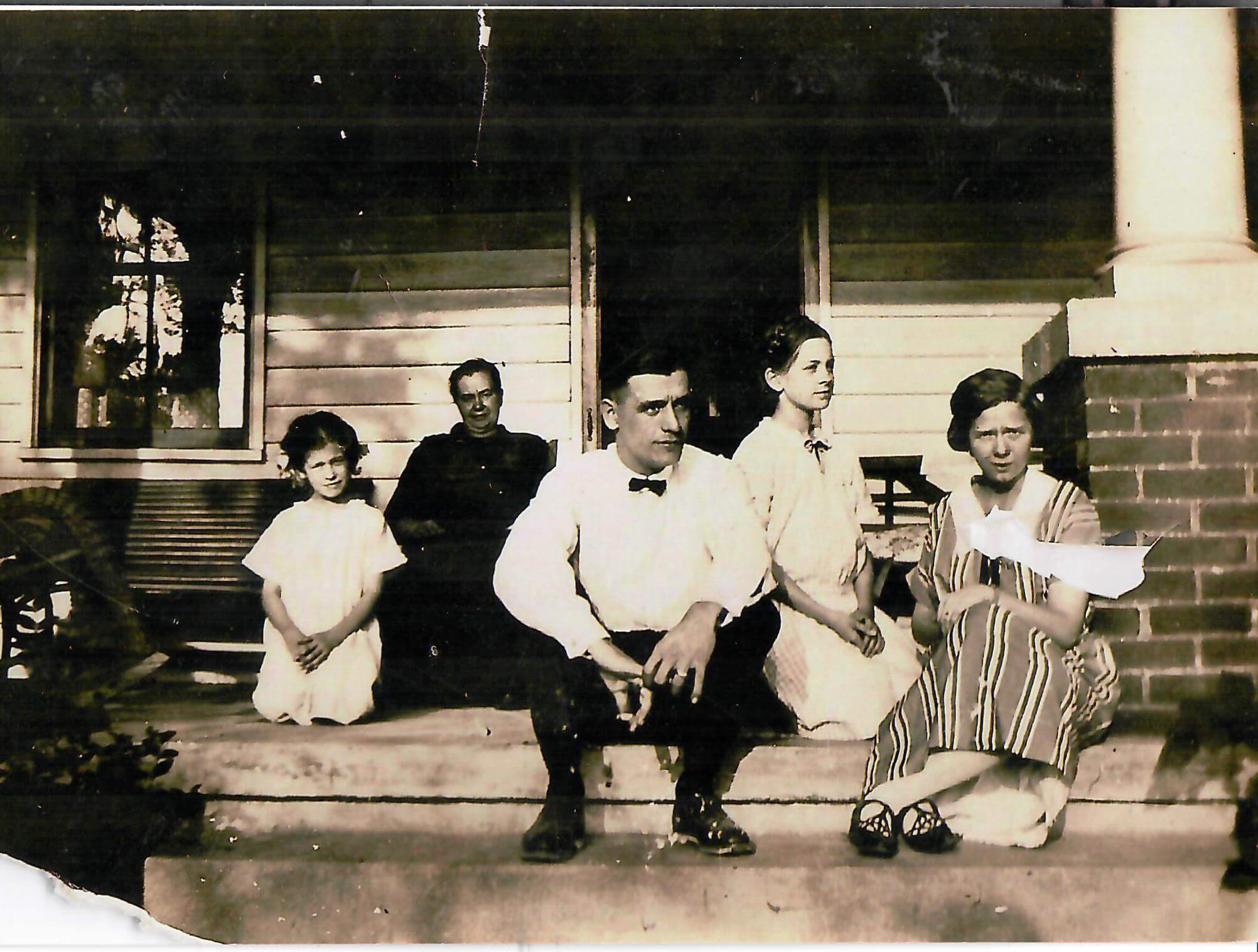
Ellis L Keller & Family in Lebanon, PA (Photo courtesy of Michael Strauss)
Draft Classification Lists
Once your ancestors registered they needed to be classified and assigned a draft status, which is found on the draft classification lists. These records haven’t been digitized and are only available onsite at the National Archives branch located in Morrow, Georgia. This branch is located in the suburbs of Atlanta.
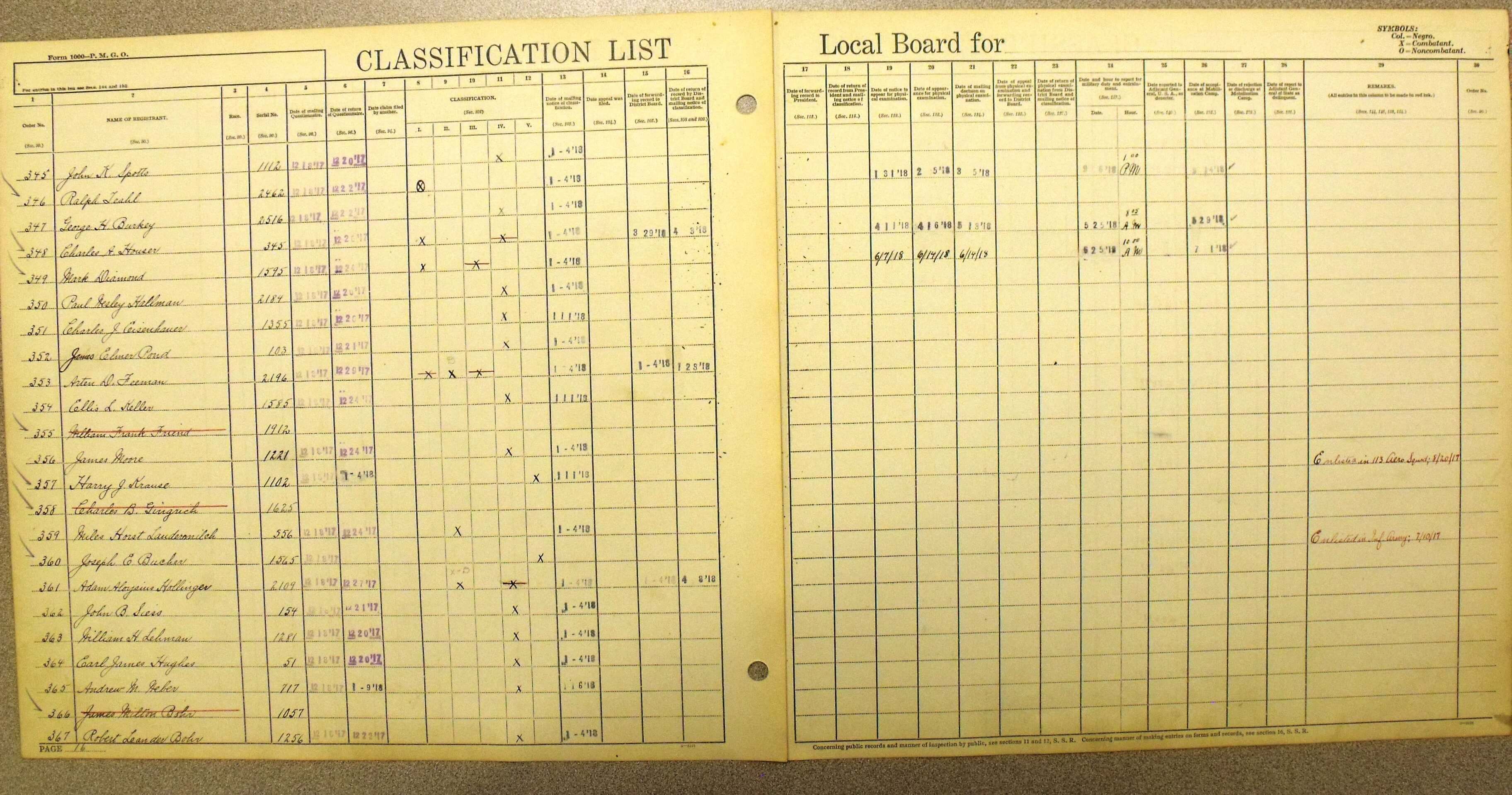
Image courtesy of Michael Strauss
The records for World War I and the Selective Service are found in Record Group 163 at the National Archives. The Archives allows for email inquiries and for a modest fee they will copy the classification history of any ancestors you request.
To learn more about the regulations governing the Selective Service Act, click here to view the complete regulations for World War I at the Hunter College, part of the City University of New York (CUNY). It includes the complete listing of classifications and all of the forms filled out by the registrants.
Searches should also be conducted in the National Archives regional office located in College Park, Maryland. This is often referred to as Archives II. This office in one of the central repositories for other draft registration materials from World War I including:
- records of physicals
- questionnaires
- lists of men examined
- deserters
- delinquents [slackers]
- men who reported for duty
- appeals to the President
The following link goes directly to their collection of records.
Other World War I Draft Records
As you can see there are a number of wonderful resources you can use to learn more about your ancestors during the World War I period. In addition to onsite and online resources already mentioned, it is possible that you may have relevant papers in your own personal family collection. These can include the registration card that was given to your ancestor proving that he had registered for the draft.
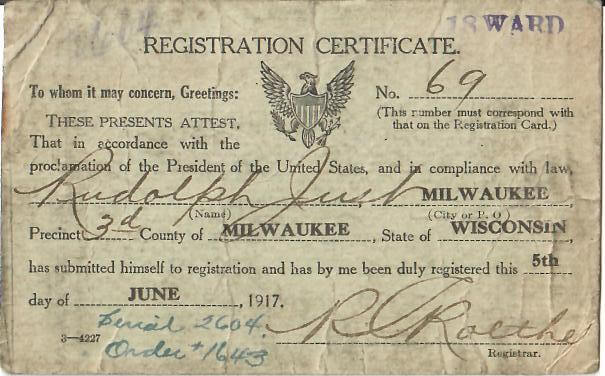
Rudolph Just-WWI Registration Certificate (courtesy of Michael Strauss)
Also keep an eye out for the postcard that was mailed to him notifying him of the draft status. Here’s an example from Rudolph Just of Milwaukee, Wisconsin:

Rudolph Just-WWI Draft Classification Postcard (Images courtesy of Michael Strauss)
For a complete listing of all of the classifications for World War I through World War II and including post-war service for the Vietnam and Korean warm, contact the college at Swarthmore University in Pennsylvania. They have recorded each of the listings along with explanations. Once this is done, contact the Archives in College Park, MD to obtain other Selective Service records. All records are part of Records Group 147.
 Resources for Learning More About World War I and Military History
Resources for Learning More About World War I and Military History
Move forward in time from the Great War to World War II with Michael’s article Deciphering Draft Registration Cards for Genealogy: World War II.
Then, click the image on the right to head to our comprehensive collection of articles on military history.

Author: Michael Strauss, AG
Michael Strauss, AG is the principal owner of Genealogy Research Network and an Accredited Genealogist since 1995. He is a native of Pennsylvania and a resident of Utah and has been an avid genealogist for more than 30 years. Strauss holds a BA in History and is a United States Coast Guard veteran.


